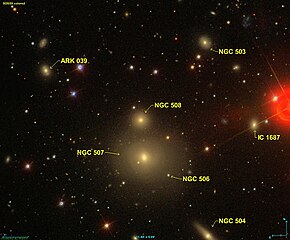| NGC 508 | |
|---|---|
 SDSS view of NGC 508 | |
| Observation data (J2000[1] epoch) | |
| Constellation | Pisces[2] |
| Right ascension | 01h 23m 40.6s[3] |
| Declination | +33° 16′ 49″[3] |
| Redshift | 0.01835 ± 0.00007[1] |
| Heliocentric radial velocity | (5451 ± 21) km/s[1] |
| Distance | 247 Mly[4] |
| Apparent magnitude (V) | 13.1[2] |
| Apparent magnitude (B) | 14.1[2] |
| Characteristics | |
| Type | E[2] |
| Apparent size (V) | 1.1' × 1.1'[2] |
| Other designations | |
| PGC 5099, UGC 939, GC 295, MGC +05-04-045, 2MASS J01234058+3316502 [1][5] | |
Preview warning: Page using Template:Infobox galaxy with unknown parameter "upright"
NGC 508, also occasionally referred to as PGC 5099 or UGC 939, is an elliptical galaxy in the constellation Pisces.[2] It is located approximately 247 million light-years from the Solar System[4] and was discovered on 12 September 1784 by British astronomer William Herschel.[5] [6]
- ^ a b c d "NGC 508". Retrieved 2017-12-09.
- ^ a b c d e f "Revised NGC Data for NGC 508". spider.seds.org. Retrieved 2017-10-05.
- ^ a b "Your NED Search Results". ned.ipac.caltech.edu. Retrieved 2017-10-05.
- ^ a b An object's distance from Earth can be determined using Hubble's law: v=Ho is Hubble's constant (70±5 (km/s)/Mpc). The relative uncertainty Δd/d divided by the distance is equal to the sum of the relative uncertainties of the velocity and v=Ho
- ^ a b "New General Catalog Objects: NGC 500 - 549". cseligman.com. Retrieved 2017-10-16.
- ^ "astronomy-mall.com/Adventures.In.Deep.Space/NGC%201-7840%20complete.htm".